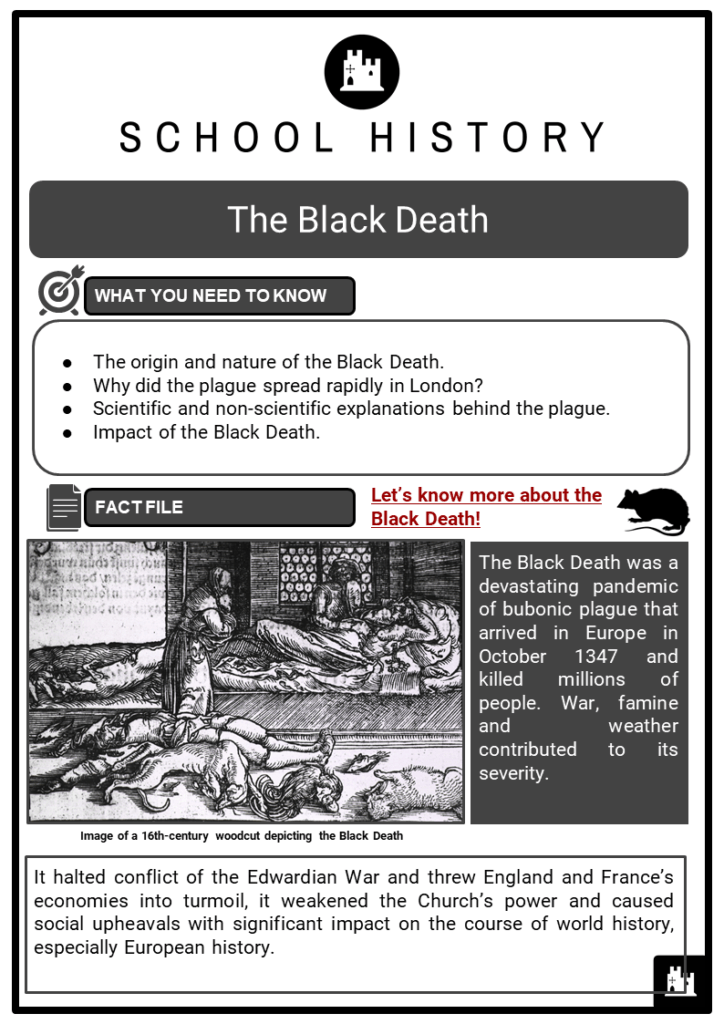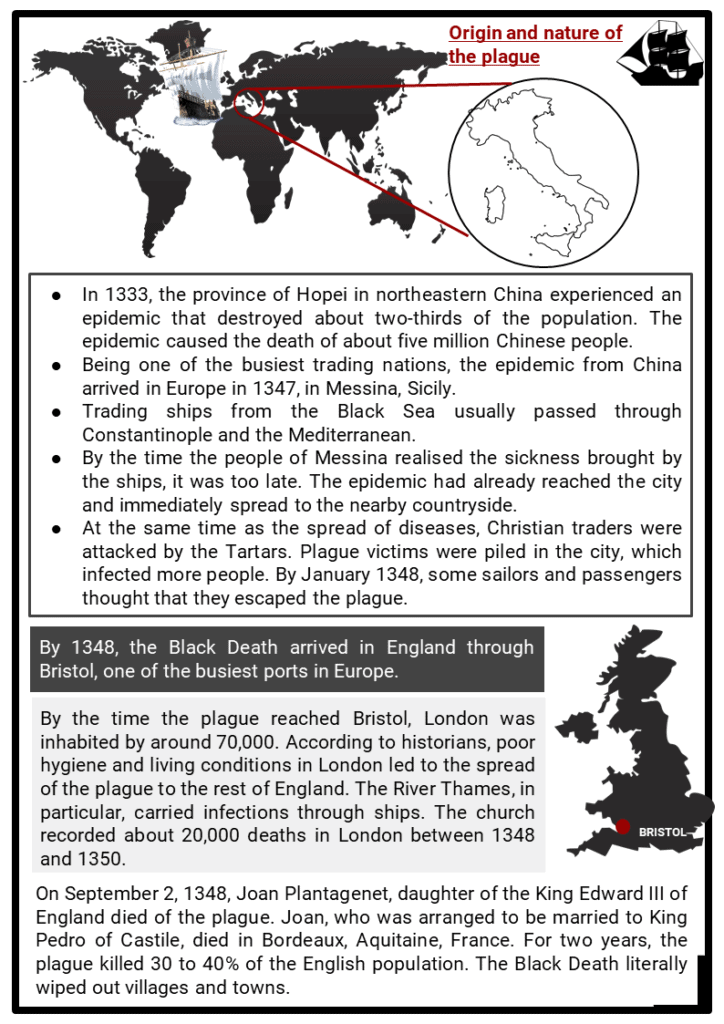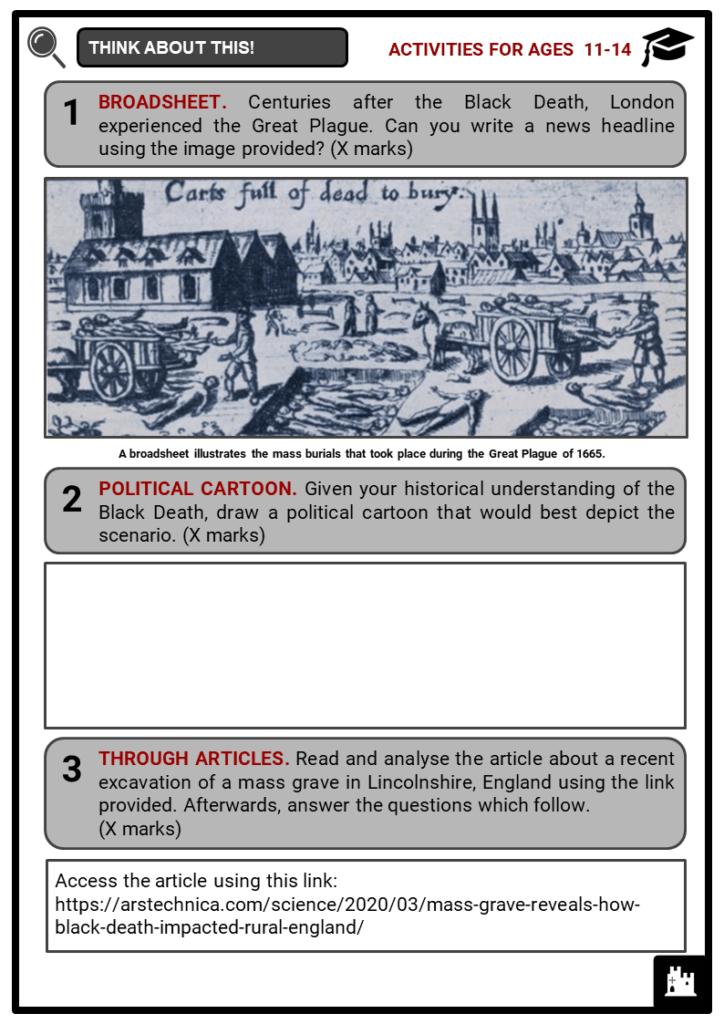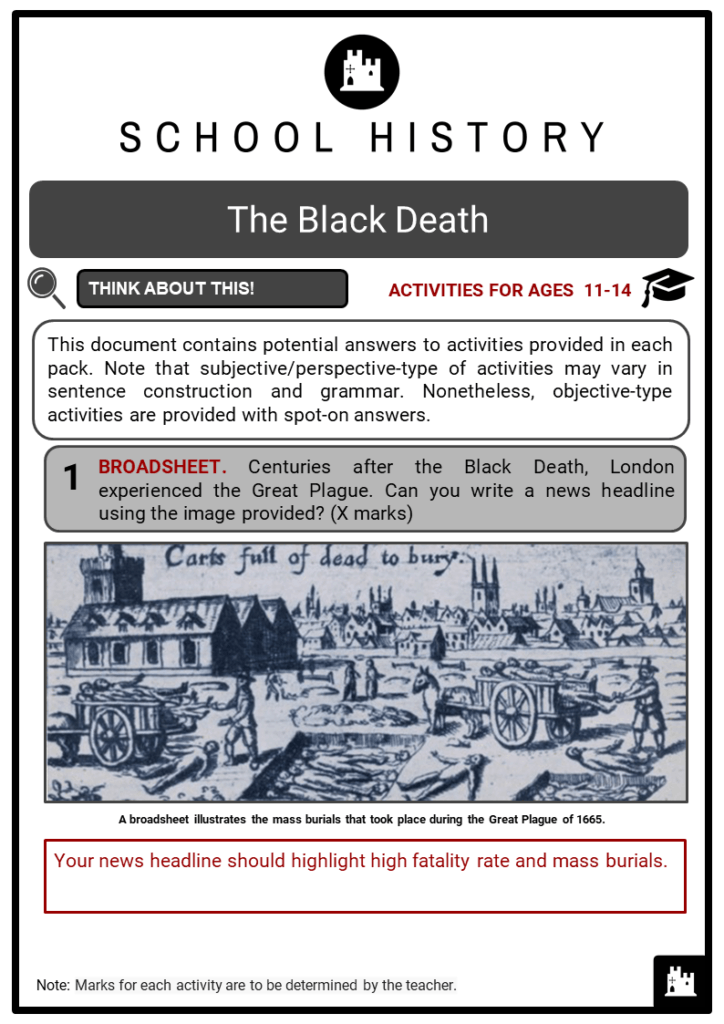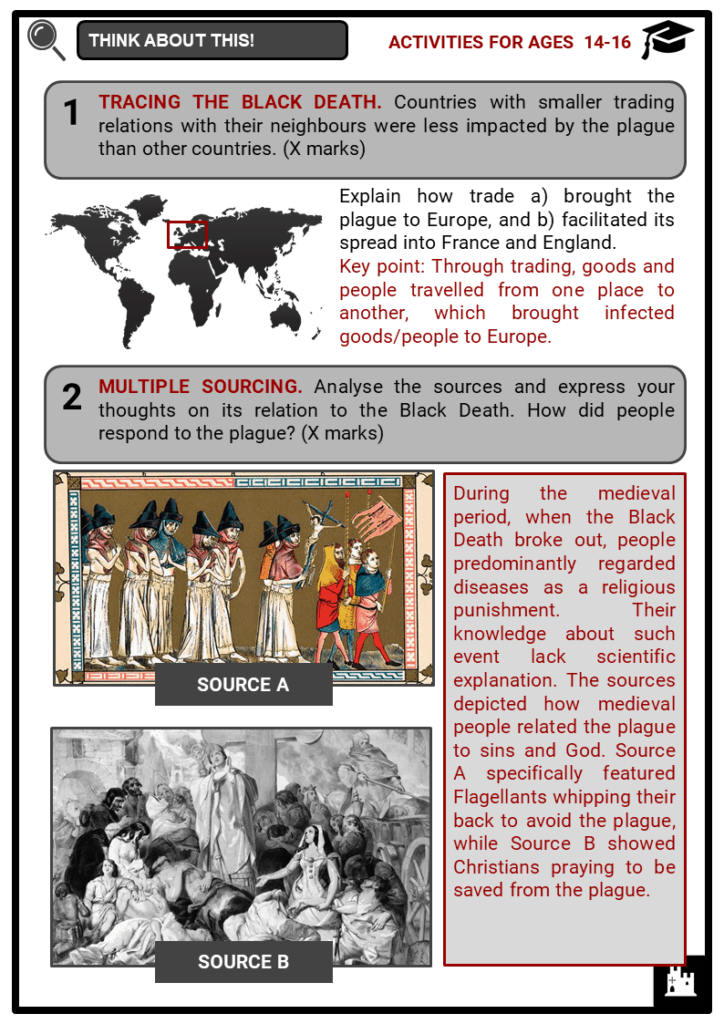Download The Black Death Worksheets
Do you want to save dozens of hours in time? Get your evenings and weekends back? Be able to teach The Black Death to your students?
Our worksheet bundle includes a fact file and printable worksheets and student activities. Perfect for both the classroom and homeschooling!
Table of Contents
Add a header to begin generating the table of contents
Summary
- The origin and nature of the Black Death.
- Why did the plague spread rapidly in London?
- Scientific and non-scientific explanations behind the plague.
- Impact of the Black Death.
Key Facts And Information
Let’s know more about the Black Death!
- The Black Death was a devastating pandemic of bubonic plague that arrived in Europe in October 1347 and killed millions of people. War, famine and weather contributed to its severity.
- It halted conflict of the Edwardian War and threw England and France’s economies into turmoil, it weakened the Church’s power and caused social upheavals with significant impact on the course of world history, especially European history.
Origin and nature of the plague
- In 1333, the province of Hopei in northeastern China experienced an epidemic that destroyed about two-thirds of the population. The epidemic caused the death of about five million Chinese people.
- Being one of the busiest trading nations, the epidemic from China arrived in Europe in 1347, in Messina, Sicily.
- Trading ships from the Black Sea usually passed through Constantinople and the Mediterranean.
- By the time the people of Messina realised the sickness brought by the ships, it was too late. The epidemic had already reached the city and immediately spread to the nearby countryside.
- At the same time as the spread of diseases, Christian traders were attacked by the Tartars. Plague victims were piled in the city, which infected more people. By January 1348, some sailors and passengers thought that they escaped the plague.
- By 1348, the Black Death arrived in England through Bristol, one of the busiest ports in Europe.
- By the time the plague reached Bristol, London was inhabited by around 70,000. According to historians, poor hygiene and living conditions in London led to the spread of the plague to the rest of England. The River Thames, in particular, carried infections through ships. The church recorded about 20,000 deaths in London between 1348 and 1350.
- On September 2, 1348, Joan Plantagenet, daughter of the King Edward III of England died of the plague. Joan, who was arranged to be married to King Pedro of Castile, died in Bordeaux, Aquitaine, France. For two years, the plague killed 30 to 40% of the English population. The Black Death literally wiped out villages and towns.
- Why London?
- The plague easily flourished in London, given the foul conditions of the city. People usually emptied their chamber pots out of the window, straight to the streets. Moreover, many residents owned pigs inside their homes that were often in the streets for food.
- Cities were strikingly filthy, infested with lice, fleas, and rats. Narrow streets, open sewage and dense housing that was overcrowded with poor ventilation, along with malnutrition and poor hygiene facilitated the spread of the plague.
- Infection was indiscriminate, affecting men, women and children of all classes although urban peasants were particularly affected due to their unsanitary living conditions.
- All social classes were affected, although the lower classes, living together in unhealthy places, were most vulnerable.
- Eighteen months after the plague reached London, about 400,000 people perished. As expected, they were buried in mass graves, especially those who were poor.
- With the increasing death toll, the Smithfield cemetery was hurriedly opened by the Bishop of London. In addition, a secondary cemetery was opened at Spittle Croft.
- The same year, Edward III ordered cleaning of the streets of London to further avoid contamination, however, the council replied that street sweepers and cleaners had died of the plague.
- Symptoms and beliefs
- Symptoms started with large swellings (buboes) in the groin, neck or armpits that would ooze blood and pus.
- Black spots appeared on the arms and thighs accompanied by fever, chills, vomiting blood, diarrhoea, aches and pains.
- Death followed, two to seven days after the initial infection.
- No one knew exactly how the Black Death was transmitted, nor how to prevent or treat it. As a result, people believed in the following:
- Superstition, belief in God’s wrath, astrology and crude theories grew.
- Physicians used unsanitary and dangerous procedures such as bloodletting and boil-lancing.
- Burning aromatic herbs and bathing in rosewater or vinegar was also tried with little success. This was rooted in miasma theory.
- Other treatments included placing a frog’s belly on the boil. The frog would swell up and explode.
- Known as the Vicary method, people shaved the hen’s butt and strapped on the swollen lymph nodes of the infected person. When the chicken got sick, the procedure will be repeated until the chicken or the sick person recover.
- In medieval Europe, bathing with urine was a popular treatment to many diseases, including the plague. Urine from non-infected people would be collected and sold to sick people during the plague.
Science behind the plague
- According to scientists today, the Black Death was caused by the spread of a bacillus called Yersinia pestis (named after Alexandre Yersin, a French biologist who discovered the bacterium in the 19th century). Many small mammals, such as rats, rabbits, and squirrels can host the bacteria. In the case of England, rats populated the streets and houses.
- Scientists discovered that the fleas Xenopsylla cheopis hosting on rats caused the plague to spread to humans. The transmission occurs through inhalation of infected droplets or direct contact with the blood of infected ones.
- More recent studies suggest that ectoparasites like body lice and human fleas could have caused the spread of the epidemic.
- Another theory suggests that there was a lack of archaeological evidence to support that rats and their fleas spread the plague. A field archaeologist argued that since the plague caused the death of tens of thousands of people, there should also be thousands of rat bones found in London.
- Barney Sloane suggests that the rapid spread of the plague was from person to person and not through rat-born flea bites.
- There are three forms of plague: bubonic, septicaemic and pneumonic. The Bubonic plague characterised by painful swollen lymph nodes, called buboes is the most common.
Impact of the plague
- The Black Death that devastated Europe was one of the most infamous pandemics in world history. Some referred to it as the Great Pestilence and the Great Mortality.
- Some historians argued that the plague caused the death of half of Europe’s population.
- Due to lack of knowledge about the disease, it spread easily among family members and caretakers, but when they observed the symptoms, families were ripped apart. Streets of poor towns and cities were littered with dead bodies. As a result, they often did mass burials or burning of bodies.
- With the fear of getting infected, people refrained from visiting public places and doing communal activities in markets and churches.
- Great economic loss was the second impact of the plague. Most trading ports were closed as merchants feared being infected.
- Regardless of social class, the rich and poor were both hit by the plague. Such pressure put the ruling monarchs in an uncontrollable political crisis.
- Frustrated with the nature and cause of the plague, scholars began to drive away diagnoses based on astrology and superstition. Higher education on public health, hospital management, and physical science emerged.
- Those who survived the death suffered a crisis of faith. They began to doubt the existence and power of God, as the Church failed to provide any help. As a result, several heretical movements emerged, and personal private chapels were built.
- People in Europe had the concept of death in mind as was expressed through art. The Dance of Death, or danse macabre, was often depicted in poetry, drama, music, and visual art, which reminded many people that death was everywhere.
- A reduction of the population resulted in higher wages and more available land and food for peasants because of less competition for resources.
- Serfdom disappeared for a century. Peasants' obligations to remain on their traditional holdings weakened. The landowning classes saw the demand for higher wages as social upheaval and insubordination. In 1349, Edward III of England (right) passed the Ordinance of Labourers, fixing wages at pre-plague levels.
- Lack of understanding of the transmission of the Black Death led to beliefs that the pestilence was the wrath of God for moral degradation.
- Religious fervour and fanaticism bloomed.
- Flagellants publically beat themselves in penance for the town.
- Jews’ ritual washing meant they were less affected - attracting suspicion and persecution.
- Heretics and troublemakers were also killed.
- Monasteries, monks and priests were particularly vulnerable and a shortage of clergy resulted.
- Loss of faith in the power of the Church resulted from its inability to cure or prevent the plague.

